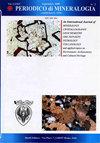来自南乌拉尔的青铜时代冶金炉渣:类型、矿物学和铜来源
IF 1.2
4区 地球科学
Q3 GEOCHEMISTRY & GEOPHYSICS
引用次数: 6
摘要
本文对南乌拉尔地区发现的可追溯到公元前4000年至1300年青铜时代的铜冶金渣进行了调查。根据矿物成分,可区分四种主要矿物学类型:富铬尖晶石型橄榄石、硫化物型橄榄石、含硫化物的玻璃质和辉石型。第一种类型的矿渣由分区橄榄石、磁铁矿和玻璃组成,其具有富铬尖晶石和蛇纹岩的残余物,表明使用了超基性岩中的天青-孔雀石矿石。这些发现是在西乌拉尔的亚姆纳早期遗址中发现的,在辛塔什塔文化中广泛存在。第二类由骨架橄榄石晶体、磁铁矿和含硫化铜液滴的乌斯岩组成。其类型属于阿拉库尔期。原料来源是VMS、矽卡岩和铜斑岩矿床二次富集带的硫化矿。含硫化物玻璃型主要由含铜玻璃和硫化物液滴组成。矿渣是在Srubna场地回收的。原料来源为含铜砂岩的富硫化矿。辉石类型由辉石、辉长岩和/或硅灰石组成,含有少量玻璃和硫化物包裹体。根据玻璃成分,矿渣可分为含铜砂岩的顺乌拉尔型和以各种火山热液矿床为原料的反乌拉尔型。矿渣玻璃中必需的Ca、P、Ba和REE杂质表明使用了重晶石、方解石和骨熔剂。相图、结晶温度和实验数据显示,炉渣熔体温度在1150–1300°C之间。本文章由计算机程序翻译,如有差异,请以英文原文为准。
Bronze Age metallurgical slags from the South Urals: types, mineralogy and copper sources
In the paper, an investigation of copper metallurgical slags found in the South Urals and dating to the Bronze Age between 4000 and 1300 BCE is carried out. Four main mineralogical types are distinguished according to their mineral composition: Cr-rich spinel containing olivine, sulphide-containing olivine, sulphide containing glassy and pyroxene type. First type of slags is composed of zoned olivine, magnetite and glass having relicts of Cr-rich spinels and serpentinites that indicate the use of azurite-malachite ores from ultrabasic rocks. These finds were determined in sites of the Early Yamna period in the Cis-Urals and are widespread in Sintashta culture. The second type is composed of skeletal olivine crystals, magnetite and wustite with copper sulphides droplets. It type belongs to Alakul period. The raw material sources are sulphide ores from a secondary enrichment zone of VMS, skarn and Cu-porphyry deposits. The sulphide containing glassy type is mainly composed of glass with copper and sulphide droplets. The slags were recovered in the Srubna sites. The raw material sources were rich sulphide ores of cupriferous sandstones. The pyroxene type is composed of augite, pigeonite and/or wollastonite with a small amount of glass and sulphide inclusions. According to the composition of glass, slags can be distinguished into the Cis-Uralian type, including cupriferous sandstones, and Trans-Uralian type having various volcanogenic-hydrothermal deposits as raw materials. Essential Ca, P, Ba and REE impurities in slag glass demonstrate the use of barite, calcite and bone fluxes. The phase diagrams, crystallisation temperatures and experimental data revealed that slag melt temperatures ranged between 1150–1300 ° C.
求助全文
通过发布文献求助,成功后即可免费获取论文全文。
去求助
来源期刊

Periodico Di Mineralogia
地学-地球化学与地球物理
CiteScore
1.50
自引率
14.30%
发文量
0
审稿时长
>12 weeks
期刊介绍:
Periodico di Mineralogia is an international peer-reviewed Open Access journal publishing Research Articles, Letters and Reviews in Mineralogy, Crystallography, Geochemistry, Ore Deposits, Petrology, Volcanology and applied topics on Environment, Archaeometry and Cultural Heritage. The journal aims at encouraging scientists to publish their experimental and theoretical results in as much detail as possible. Accordingly, there is no restriction on article length. Additional data may be hosted on the web sites as Supplementary Information. The journal does not have article submission and processing charges. Colour is free of charges both on line and printed and no Open Access fees are requested. Short publication time is assured.
Periodico di Mineralogia is property of Sapienza Università di Roma and is published, both online and printed, three times a year.
 求助内容:
求助内容: 应助结果提醒方式:
应助结果提醒方式:


